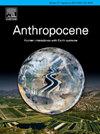Lead legacy of pre-industrial activities in lake sediments: The case study of the Lake Accesa (Southern Tuscany, Italy)
IF 3.3
2区 地球科学
Q2 ENVIRONMENTAL SCIENCES
引用次数: 0
Abstract
In recent decades, interest has grown in understanding how pre-industrial activities have contributed to trace metals pollution into the environment at the local and regional scales. Southern Tuscany hosts some of the most important metallogenic provinces in Italy exploited for almost the last three millennia. Studying the history of trace metals pollution in this area offers insights into the temporal and spatial scope of human-environment interactions, evaluates the severity of pollution, and can trace the local natural background values. To explore these aspects, trace metals, major elements, and lead (Pb) isotope ratios were analyzed in an 8000-year sediment records from Lake Accesa, a karst lake located on the southern border of the Colline Metallifere mining district. The findings indicate that Pb in Lake Accesa is mainly related to sulfide polymetallic deposits that surround the lake catchment. The first signal of Pb pollution dates to about 3300 BCE (Before Common Era) during the Copper Age and it is consistent with the archaeological evidence of Southern Tuscany. Additional human-induced Pb pollution signals can be observed in the Bronze Age (∼1550 BCE), and a long phase beginning in the Middle Ages (from ∼700 CE[Common Era]). Between 1000 and 1700 CE, Pb reached the highest concentrations, corroborating the intensity of mining activity during and after the Medieval period. These findings reveal that pre-industrial activities left a significant legacy of potential toxic elements in the environment, resulting in pollution levels that exceed those related to recent activities associated with the Anthropocene. The Lake Accesa record further indicates that mining of sulfide deposits in the Etruscan period was minimal and even completely negligible during Roman times, probably due to the exploitation of other ore deposits.
湖泊沉积物中工业化前活动的铅遗产:阿accesa湖(意大利托斯卡纳南部)的案例研究
近几十年来,人们越来越有兴趣了解工业化前的活动如何在地方和区域尺度上导致微量金属污染进入环境。托斯卡纳南部拥有意大利一些最重要的成矿省份,在过去的近三千年里一直被开采。研究该地区微量金属污染的历史,可以洞察人与环境相互作用的时空范围,评估污染的严重程度,并可以追踪当地的自然背景值。为了探索这些方面,我们分析了位于Colline Metallifere矿区南部边界的喀斯特湖泊Accesa的8000年沉积物记录中的痕量金属、主元素和铅(Pb)同位素比率。结果表明,阿达达湖的铅主要与湖区周围的硫化物多金属矿床有关。铅污染的第一个信号可以追溯到大约公元前3300年的铜器时代,这与南托斯卡纳的考古证据是一致的。在青铜时代(约公元前1550年)和中世纪(约公元前700年)开始的一段很长的时期,可以观察到其他人为引起的铅污染信号。在公元1000年至1700年之间,铅达到了最高浓度,证实了中世纪时期和之后采矿活动的强度。这些发现表明,工业化前的活动在环境中留下了潜在有毒元素的重要遗产,导致污染水平超过了与人类世相关的近期活动。阿卡塔湖的记录进一步表明,在伊特鲁里亚时期,硫化物矿床的开采很少,甚至在罗马时代完全可以忽略不计,这可能是由于其他矿床的开采。
本文章由计算机程序翻译,如有差异,请以英文原文为准。
求助全文
约1分钟内获得全文
求助全文
来源期刊

Anthropocene
Earth and Planetary Sciences-Earth and Planetary Sciences (miscellaneous)
CiteScore
6.30
自引率
0.00%
发文量
27
审稿时长
102 days
期刊介绍:
Anthropocene is an interdisciplinary journal that publishes peer-reviewed works addressing the nature, scale, and extent of interactions that people have with Earth processes and systems. The scope of the journal includes the significance of human activities in altering Earth’s landscapes, oceans, the atmosphere, cryosphere, and ecosystems over a range of time and space scales - from global phenomena over geologic eras to single isolated events - including the linkages, couplings, and feedbacks among physical, chemical, and biological components of Earth systems. The journal also addresses how such alterations can have profound effects on, and implications for, human society. As the scale and pace of human interactions with Earth systems have intensified in recent decades, understanding human-induced alterations in the past and present is critical to our ability to anticipate, mitigate, and adapt to changes in the future. The journal aims to provide a venue to focus research findings, discussions, and debates toward advancing predictive understanding of human interactions with Earth systems - one of the grand challenges of our time.
 求助内容:
求助内容: 应助结果提醒方式:
应助结果提醒方式:


